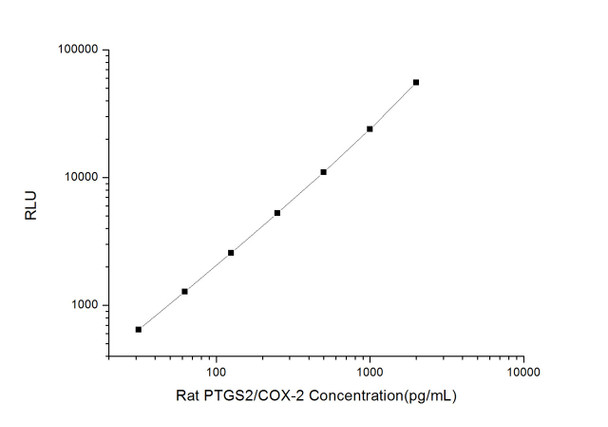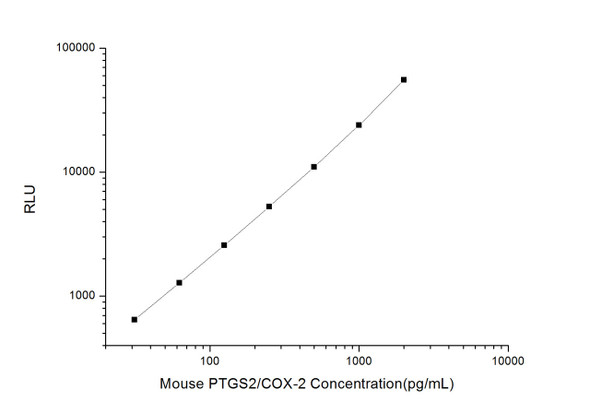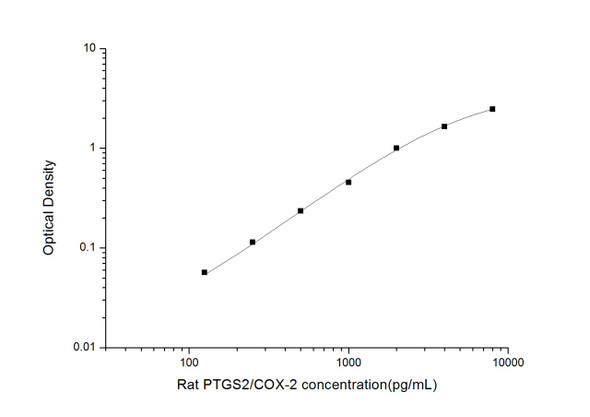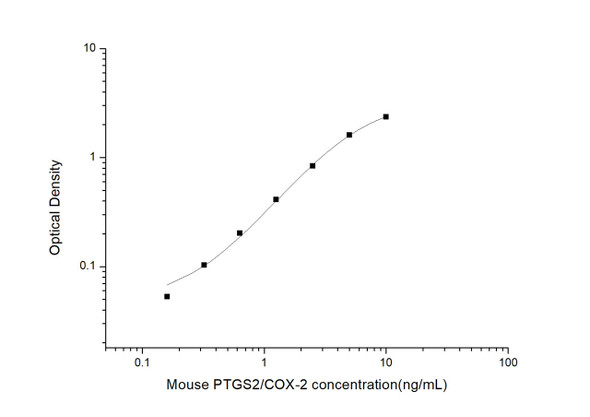Rat Signaling ELISA Kits 3
Rat PTGS2/COX-2 (Prostaglandin Endoperoxide Synthase 2) CLIA Kit (RTES00479)
- SKU:
- RTES00479
- Product Type:
- ELISA Kit
- ELISA Type:
- CLIA Kit
- Size:
- 96 Assays
- Sensitivity:
- 18.75pg/mL
- Range:
- 31.25-2000pg/mL
- ELISA Type:
- Sandwich
- Synonyms:
- COX2, GRIPGHS, PGG/HS, PGHS-2, PHS-2, hCox-2
- Reactivity:
- Rat
- Sample Type:
- Serum, plasma and other biological fluids
- Research Area:
- Metabolism
Description
| Assay type: | Sandwich |
| Format: | 96T |
| Assay time: | 4.5h |
| Reactivity: | Rat |
| Detection method: | Chemiluminescence |
| Detection range: | 31.25-2000 pg/mL |
| Sensitivity: | 18.75 pg/mL |
| Sample volume: | 100µL |
| Sample type: | Serum, plasma and other biological fluids |
| Repeatability: | CV < 15% |
| Specificity: | This kit recognizes Rat PTGS2/COX-2 in samples. No significant cross-reactivity or interference between Rat PTGS2/COX-2 and analogues was observed. |
This kit uses Sandwich-CLIA as the method. The micro CLIA plate provided in this kit has been pre-coated with an antibody specific to Rat PTGS2/COX-2. Standards or samples are added to the appropriate micro CLIA plate wells and combined with the specific antibody. Then a biotinylated detection antibody specific for Rat PTGS2/COX-2 and Avidin-Horseradish Peroxidase (HRP) conjugate are added to each micro plate well successively and incubated. Free components are washed away. The substrate solution is added to each well. Only those wells that contain Rat PTGS2/COX-2, biotinylated detection antibody and Avidin-HRP conjugate will appear fluorescence. The Relative light unit (RLU) value is measured spectrophotometrically by the Chemiluminescence immunoassay analyzer. The RLU value is positively associated with the concentration of Rat PTGS2/COX-2. The concentration of Rat PTGS2/COX-2 in the samples can be calculated by comparing the RLU of the samples to the standard curve.
| UniProt Protein Function: | COX-2: Mediates the formation of prostaglandins from arachidonate. May have a role as a major mediator of inflammation and/or a role for prostanoid signaling in activity-dependent plasticity. Homodimer. Belongs to the prostaglandin G/H synthase family. |
| UniProt Protein Details: | Protein type:EC 1. 14. 99. 1; Lipid Metabolism - arachidonic acid; Oxidoreductase Chromosomal Location of Human Ortholog: 13q21 Cellular Component: caveola; cytoplasm; endoplasmic reticulum; neuron projection; nucleus; protein complex Molecular Function:enzyme binding; heme binding; lipid binding; oxidoreductase activity, acting on single donors with incorporation of molecular oxygen, incorporation of two atoms of oxygen; prostaglandin-endoperoxide synthase activity; protein binding; protein homodimerization activity Biological Process: aging; angiogenesis; bone mineralization; brown fat cell differentiation; cyclooxygenase pathway; decidualization; embryo implantation; hair cycle; inflammatory response; learning; memory; negative regulation of apoptosis; negative regulation of calcium ion transport; negative regulation of caspase activity; negative regulation of cell cycle; negative regulation of cell proliferation; negative regulation of smooth muscle contraction; negative regulation of synaptic transmission, dopaminergic; ovulation; positive regulation of apoptosis; positive regulation of cell proliferation; positive regulation of fever; positive regulation of NF-kappaB import into nucleus; positive regulation of nitric oxide biosynthetic process; positive regulation of peptidyl-serine phosphorylation; positive regulation of prostaglandin biosynthetic process; positive regulation of smooth muscle cell proliferation; positive regulation of smooth muscle contraction; positive regulation of synaptic plasticity; positive regulation of synaptic transmission, glutamatergic; positive regulation of vasoconstriction; prostaglandin biosynthetic process; regulation of blood pressure; regulation of cell proliferation; response to cytokine stimulus; response to drug; response to estradiol stimulus; response to fructose stimulus; response to glucocorticoid stimulus; response to lipopolysaccharide; response to lithium ion; response to manganese ion; response to organic cyclic substance; response to organic nitrogen; response to organic substance; response to radiation; response to vitamin D; sensory perception of pain |
| UniProt Code: | P35355 |
| NCBI GenInfo Identifier: | 148747270 |
| NCBI Gene ID: | 29527 |
| NCBI Accession: | NP_058928. 3 |
| UniProt Secondary Accession: | P35355,Q64379, Q925V4, |
| Molecular Weight: | 69,164 Da |
| NCBI Full Name: | prostaglandin G/H synthase 2 |
| UniProt Protein Name: | Prostaglandin G/H synthase 2 |
| UniProt Synonym Protein Names: | Cyclooxygenase-2; COX-2; PHS II; Prostaglandin H2 synthase 2; PGH synthase 2; PGHS-2; Prostaglandin-endoperoxide synthase 2 |
| Protein Family: | Prostaglandin G/H synthase |
| UniProt Gene Name: | Ptgs2 |
As the RLU values of the standard curve may vary according to the conditions of the actual assay performance (e. g. operator, pipetting technique, washing technique or temperature effects), the operator should establish a standard curve for each test. Typical standard curve and data is provided below for reference only.
| Concentration (pg/mL) | RLU | Average | Corrected |
| 2000 | 55636 55806 | 55721 | 55693 |
| 1000 | 23755 24193 | 23974 | 23946 |
| 500 | 11932 10132 | 11032 | 11004 |
| 250 | 5153 5435 | 5294 | 5266 |
| 125 | 2758 2458 | 2608 | 2580 |
| 62.5 | 1382 1240 | 1311 | 1283 |
| 31.25 | 674 674 | 674 | 646 |
| 0 | 27 29 | 28 | -- |
Precision
Intra-assay Precision (Precision within an assay): 3 samples with low, mid range and high level Rat PTGS2/COX-2 were tested 20 times on one plate, respectively.
Inter-assay Precision (Precision between assays): 3 samples with low, mid range and high level Rat PTGS2/COX-2 were tested on 3 different plates, 20 replicates in each plate.
| Intra-assay Precision | Inter-assay Precision | |||||
| Sample | 1 | 2 | 3 | 1 | 2 | 3 |
| n | 20 | 20 | 20 | 20 | 20 | 20 |
| Mean (pg/mL) | 95.54 | 316.48 | 757.34 | 104.63 | 346.41 | 686.08 |
| Standard deviation | 8.68 | 33.39 | 83.69 | 11.70 | 26.54 | 48.30 |
| C V (%) | 9.09 | 10.55 | 11.05 | 11.18 | 7.66 | 7.04 |
Recovery
The recovery of Rat PTGS2/COX-2 spiked at three different levels in samples throughout the range of the assay was evaluated in various matrices.
| Sample Type | Range (%) | Average Recovery (%) |
| Serum (n=5) | 98-113 | 105 |
| EDTA plasma (n=5) | 97-110 | 103 |
| Cell culture media (n=5) | 97-111 | 102 |
Linearity
Samples were spiked with high concentrations of Rat PTGS2/COX-2 and diluted with Reference Standard & Sample Diluent to produce samples with values within the range of the assay.
| Serum (n=5) | EDTA plasma (n=5) | Cell culture media (n=5) | ||
| 1:2 | Range (%) | 102-116 | 96-114 | 101-119 |
| Average (%) | 108 | 104 | 109 | |
| 1:4 | Range (%) | 87-100 | 93-104 | 93-106 |
| Average (%) | 93 | 98 | 100 | |
| 1:8 | Range (%) | 101-113 | 97-109 | 90-101 |
| Average (%) | 107 | 103 | 96 | |
| 1:16 | Range (%) | 104-118 | 100-115 | 96-111 |
| Average (%) | 110 | 106 | 102 |
An unopened kit can be stored at 4°C for 1 month. If the kit is not used within 1 month, store the items separately according to the following conditions once the kit is received.
| Item | Specifications | Storage |
| Micro CLIA Plate(Dismountable) | 8 wells ×12 strips | -20°C, 6 months |
| Reference Standard | 2 vials | |
| Concentrated Biotinylated Detection Ab (100×) | 1 vial, 120 µL | |
| Concentrated HRP Conjugate (100×) | 1 vial, 120 µL | -20°C(shading light), 6 months |
| Reference Standard & Sample Diluent | 1 vial, 20 mL | 4°C, 6 months |
| Biotinylated Detection Ab Diluent | 1 vial, 14 mL | |
| HRP Conjugate Diluent | 1 vial, 14 mL | |
| Concentrated Wash Buffer (25×) | 1 vial, 30 mL | |
| Substrate Reagent A | 1 vial, 5 mL | 4°C (shading light) |
| Substrate Reagent B | 1 vial, 5 mL | 4°C (shading light) |
| Plate Sealer | 5 pieces | |
| Product Description | 1 copy | |
| Certificate of Analysis | 1 copy |
- Set standard, test sample and control (zero) wells on the pre-coated plate and record theirpositions. It is recommended to measure each standard and sample in duplicate. Note: addall solutions to the bottom of the plate wells while avoiding contact with the well walls. Ensuresolutions do not foam when adding to the wells.
- Aliquot 100µl of standard solutions into the standard wells.
- Add 100µl of Sample / Standard dilution buffer into the control (zero) well.
- Add 100µl of properly diluted sample (serum, plasma, tissue homogenates and otherbiological fluids. ) into test sample wells.
- Cover the plate with the sealer provided in the kit and incubate for 90 min at 37°C.
- Aspirate the liquid from each well, do not wash. Immediately add 100µL of BiotinylatedDetection Ab working solution to each well. Cover the plate with a plate seal and gently mix. Incubate for 1 hour at 37°C.
- Aspirate or decant the solution from the plate and add 350µL of wash buffer to each welland incubate for 1-2 minutes at room temperature. Aspirate the solution from each well andclap the plate on absorbent filter paper to dry. Repeat this process 3 times. Note: a microplatewasher can be used in this step and other wash steps.
- Add 100µL of HRP Conjugate working solution to each well. Cover with a plate seal andincubate for 30 min at 37°C.
- Aspirate or decant the solution from each well. Repeat the wash process for five times asconducted in step 7.
- Add 100µL of Substrate mixture solution to each well. Cover with a new plate seal andincubate for no more than 5 min at 37°C. Protect the plate from light.
- Determine the RLU value of each well immediately.






